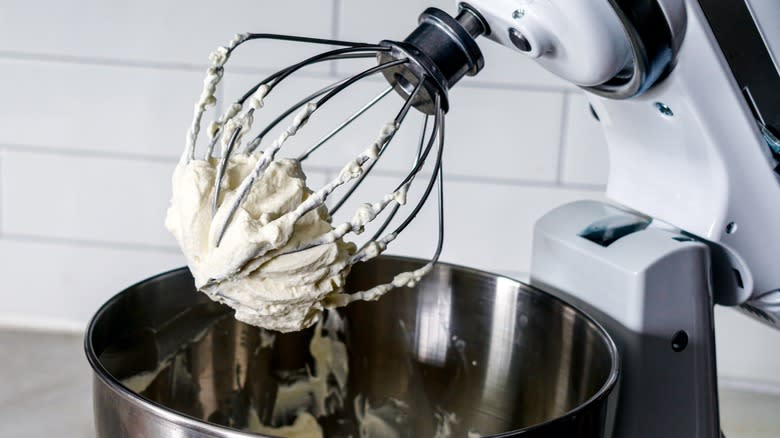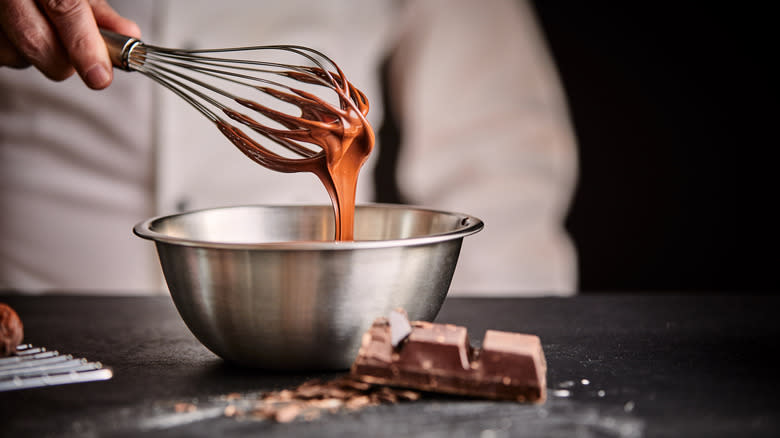Here's The Difference Between Whisking And Stirring

Stir, whisk, whip, mix, blend, and fold -- sometimes deciphering directions in a recipe is like putting together furniture based on an infographic without a supply list. The expectations can be unclear. In reality, though, a well-written recipe uses the power of precise wording to tell you everything you need to know. For example, whisking and stirring are not the same thing. The difference can be subtle but important nonetheless.
To define the two actions, remember they are both verbs. Stirring shifts materials or ingredients around. You can stir batters, sauces, cookie dough, or Chex Mix. Whisking, on the other hand, relies on the use of a whisk to swiftly move materials. Cooks commonly whisk eggs for omelets, egg whites to create the perfect meringue, dressings to emulsify ingredients, and cream to stiffen it into a sweet topping for dessert. Although there are many ways of incorporating ingredients, distinguishing between whisking and stirring can make the difference between recipe success or failure.
Read more: The Best Kitchen Gadgets You Can Buy
Whisking Vs. Stirring

One primary difference between whisking and stirring is the use of a whisk. Whisks take many shapes, all of which are intended to aerate, emulsify, and combine ingredients. In addition to manual whisks, many cooks rely on whisk attachments for stand mixers. The second key component of whisking is using a brisk movement when using the whisk. It's an aggressive motion meant to serve a specific purpose. Whether you whisk by hand or go with the mechanized form, whisking creates air channels through the ingredients. By incorporating air into the mix, whisking creates a lighter, fluffier substance.
The act of stirring has no such goal. The purpose of stirring is simply to combine ingredients. While you can technically stir some liquids with a whisk, a sturdy spoon is required for thicker doughs and other mixtures. When a recipe says to stir, it refers to a motion that pulls ingredients around the bowl or dish, incorporating them as they move. Stirring also helps with heat distribution, contributing to even temperatures in dishes such as soup. When sautéing, stirring keeps ingredients from burning and ensures uniform cooking.
The Tools And Techniques Of Whisking And Stirring

There are many different types of whisks, and they go by many names. Balloon, flat, French, wire, silicone, spring coil, and even ball whisks all have their place in the kitchen, but most home cooks only have one or two of these variations. Whatever tool you use, it's important to note there are at least three primary techniques used when whisking. The swift back-and-forth motion cuts through liquids, leaving a reliable trail of air channels and a desired whisking outcome. Moving the whisk in a circular motion isn't the best method for incorporating air because it fails to cut back through the ingredients, which is crucial for aeration and emulsification. However, it can be useful when stirring sauces. The third style of whisking involves making up and down circular motions that lift ingredients out of the bowl with each rotation. This technique is often used when whisking eggs.
Compared to whisking, stirring seems pretty straightforward. However, read your recipe carefully. Sometimes, an aggressive stir can take the desired air out of a dish. In this case, you would fold rather than stir. On the other hand, if the goal is to incorporate air into the dish, you're crossing the border into blending, whisking, or whipping. There are also dishes that require constant stirring and others that specify no stirring. In short, only stir if and when the recipe recommends it for the best results.
Read the original article on Daily Meal.

